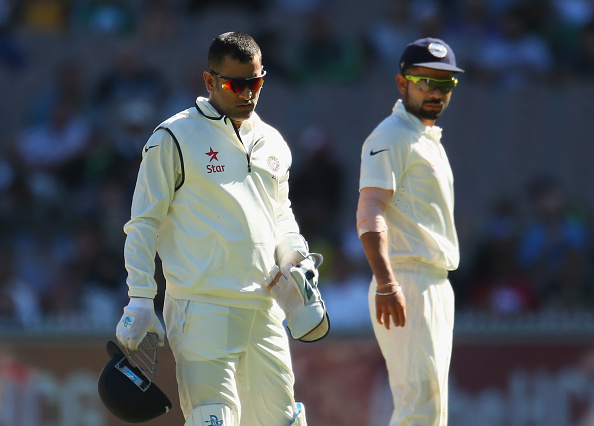Virat Kohli : a shrewd strategist or a lucky successor
When Lahiru Kumara was bowled out off a Ravichandran Ashwin delivery, the second Sri Lankan innings came to an end and with it, India registered yet another comprehensive win and clean-swept the series 3-0 for the first time ever on foreign soil. The win marked India's eighth consecutive series win.

Virat Kohli's captaincy suddenly became the highlight of the series as he registered his seventh overseas win on foreign soil surpassing MS Dhoni's tally of six. Dhoni's run as India's captain has now started to fade with Kohli starting to near his predecessor's records. Was Virat Kohli tailor made for the job and should have been handed the reins of the team earlier than he was?
Let's take a look at the factors that have contributed to the two Indian captain's success or failures. Dhoni took charge of the Test team in 2008 when the then skipper Anil Kumble suffered an injury and had to miss out on the last Test of the Border-Gavaskar series at home and announced his retirement from Test cricket. The next Test of the series was the last of Sourav Ganguly while the likes of VVS Laxman, Sachin Tendulkar, Rahul Dravid, and Virender Sehwag continued to lend their services to the Indian team although being in the twilight of their careers.
The departure of Kumble and inconsistency of Harbhajan Singh left India without seasoned spinners who earlier played a pivotal role in India's success at home and away. Meanwhile, the Indian middle-order was thrown into a frenzy with the averages of veterans VVS Laxman and Sachin Tendulkar deteriorating with every series while then newcomer Virat Kohli was still finding his feet in the longest format of the game. Therefore, Dhoni was handed a team that was going through a huge transition of sorts but the shortcomings did not stop the Ranchi lad from leading India to the top of the Test team rankings in 2009. However, Dhoni's remarkable achievement was overshadowed when India lost eight consecutive matches overseas during the 2011/12 period.

 © BCCI
© BCCIOn the other hand, when Kohli was handed over the reins of the team on December 30th, 2014 in the aftermath of Dhoni's retirement, he had a well-balanced team at his disposal and plenty of options to choose from. Ravindra Jadeja and Ravichandran Ashwin, who jointly topped the Test bowler rankings in March this year, have spearheaded India's bowling attack at home and around the World. Jadeja made his debut in the Indian team in December 2012 when he was considered a tailor-made player for the shorter formats of the game. However, Dhoni's undying belief in the Saurashtra all-rounder helped Jadeja become India's most lethal bowling entity and world's best all-rounder in the world.

 © BCCI
© BCCIAshwin, like Jadeja, was subjected to great criticism during 2012 when the Tamil Nadu spinner struggled with form and found wickets hard to come by. But it all changed when he was brought back into the side under Dhoni and the duo took multiple wickets together that helped Ashwin regain confidence and get back to his wicket taking ways making him Kohli's go-to man under tight situations.
India was dangerously short of pace bowling during 2011-12 when Zaheer Khan was on the decline while Umesh Yadav and R. Vinay Kumar were still new to the format which hurt India's chances of being successful on the seam-friendly pitches of England and Australia. However, it has all changed as the likes of Bhuvenshwar Kumar, Mohammed Shami, and Umesh Yadav, all of whom made a debut under Dhoni, have been sensational in the red-ball format.
Further, India's batting department witnessed a huge transformation of sorts after legends like Dravid, Laxman, Sehwag, and Tendulkar announced their retirement from cricket. Dhoni had to face the brunt of the situation and India found Laxman's and Dravid's replacement hard to come by. Cheteshwar Pujara and Ajinkya Rahane showed promise with the bat but the former's form continued to play hide and seek outside of the sub-continent until 2015. Since then, Pujara has become India's most dependable batsman in Tests scoring at an average of over 52 runs per innings, a feature that was lacking in the team under Dhoni.
Moreover, India discovered Shikhar Dhawan in 2013 and the Delhi batsman left his imprint on the game with his very first innings scoring a century on his debut. However, Dhawan failed to replicate his performance in the very same year and lost his place in the team leaving a void at the top of the Indian innings until KL Rahul announced himself on the scene. But it was too late for Dhoni, who was playing his last Test match in Australia and since then the Karnataka batsman has made the position his very own. Rahul's consistency has helped India architect major wins over strong opponents at home and his world-record equalling seventh consecutive half-century was an evidence of the same.
When Kohli was adjudged by the BCCI to succeed Dhoni he was blessed with the perfect Indian team with all the players playing to their potential and justifying captain's decision with their performances. On the other hand, Dhoni was burdened with the responsibility of rebuilding the Indian squad after the then regulars bid farewell to the world of cricket. Dhoni still led the men in blue to remarkable successes setting up a strong platform for Kohli to take over which the Delhi lad has utilized to the fullest.
And, ever since the change of leadership, India has played mostly at home against strong oppositions while touring West Indies and Sri Lanka on foreign tours. Kohli is yet to be tested against a strong opposition under challenging conditions and will have to succeed in the upcoming away series against South Africa and England to prove his mettle as a captain and assert his dominance.

Comments
Sign up or log in to your account to leave comments and reactions
0 Comments